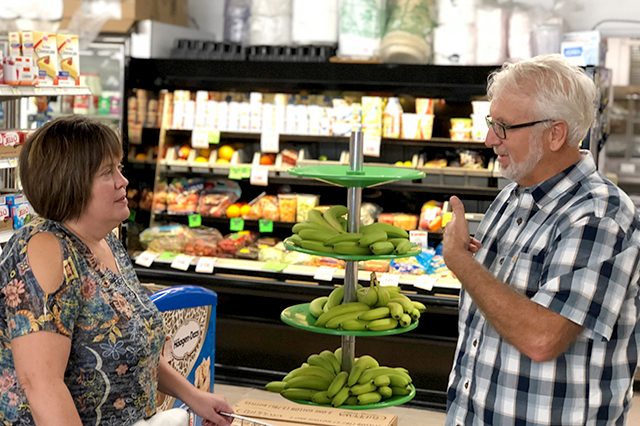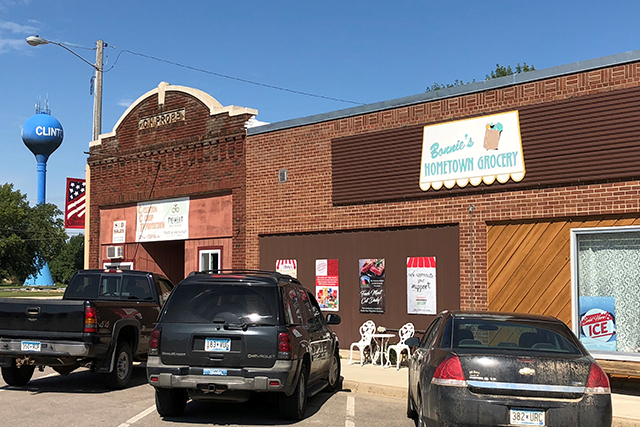About 10 years ago, Kathryn Draeger and her family moved from St. Paul to a farm near Clinton, in western Minnesota’s Big Stone County, where they raise grass-fed beef cattle, organic soybeans and barley.

[div class="caption"]Kathryn Draeger[/div]
One question quickly came to mind after she began to shop for groceries in this region: How could rural grocers offer more of the fresh produce that is grown in the farm fields all around them?
“These rural grocery stores used to serve a role in the farm economy,” she said. “People used to bring in eggs and other things, and that role had long been a part of the food supply. But this has gotten removed from the system.”
Instead, Draeger lamented, Minnesota consumers often end up buying carrots from California or apples from New Zealand. “How do we reinvigorate these (grocery) stores so that they are the first stop in a local food supply chain — rather than the last stop in a global food chain?” she asked. “How do we make the supply chain work for local foods, other than corn and soybeans?”
Starting this week, Extension will try to answer that question as it kicks off a pilot project that seeks to restore the local farmers’ place in the food supply — a potential benefit to both growers, who could sell more of their fruits and vegetables, and to rural grocers, who could offer more of the fresh produce that might attract customers.
The project, informally called “backhauling,” was to get a trial run today when Big Stone Garlic, a local small producer, delivers a pallet of garlic bulbs to Bonnie’s Hometown Grocery in Clinton, where the garlic will be loaded onto a truck for its return trip to Mason Brothers, a wholesaler in Wadena, for wider distribution.
The idea is to connect small- and medium-sized growers with wholesalers — using rural grocery stores like Bonnie’s as centralized docking points — who could then distribute the produce to regional grocers.
Draeger garnered a $500,000 grant from the U.S. Department of Agriculture to kick start the backhaul project. Extension will monitor the program, following the produce as it makes its way through the wholesale process to wherever it might end up — “Hallock or Grand Marais, or Lunds & Byerlys,” as Draeger put it.
More local, less global
Three years ago, in an effort to better understand the economic health of rural grocery stores, Extension surveyed about 250 grocers in small Minnesota towns — those with fewer than 2,500 residents.
Among its many findings, the agency concluded that, in order to thrive, small grocers needed to find ways to set themselves apart from chain stores; one of its suggestions was to carry fresh, locally grown food — a demand that grocers say is on the rise.
More than half of the respondents to the survey said that meeting customer demand for locally grown produce was a challenge. While three out of four grocers said they purchased some produce from local farmers, just 4 percent said local farmers were a major supplier of fresh produce. Here’s a link to the survey as it relates to fresh produce and rural grocers.

[div class="credit"]MinnPost photo by Gregg Aamot[/div]
[div class="caption"]Bonnie Carlson, left, and Les Olson visit at Carlson’s store, Bonnie’s Hometown Grocery, in Clinton, where she sells garlic grown on Olson’s farm.[/div]
Les Olson would love to be a major supplier. This summer, Olson and his wife, Jessica, sold their home in Brooklyn Park and moved to their farm in Big Stone County, where they have been growing garlic on the side for the past seven years.

[div class="caption"]Clinton, Minnesota[/div]
Like many small farmers, the Olsons and Swensons are in a Catch-22; they don’t grow enough produce for the wholesalers that serve grocery stores and they don’t sell enough at niche markets to make much money. Invariably, Big Stone Garlic ends up giving much of its garlic away — or, worse yet, watching some of it spoil. “We grow really good garlic here,” Les Olson said, “and we want to sell all that we grow.”
When Extension approached the Olsons and Swensons about taking part in the backhaul project, they readily agreed.
Another kind of market
Selling produce through wholesalers can be difficult, especially for small growers, because of the pricing, transportation costs, regulations related to safety and packaging standards and other logistical barriers.
Consequently, many farmers have long sold their fruits and vegetables at farmers markets. Yet many growers have become increasingly frustrated by the limits of those outlets, said Joe Luetmer, a former Kraft Foods Group executive who is the general manager of Local Harvest Market, a web-based produce distributor in Alexandria.
“Farmers go to (farmers markets) and they have some nice interaction with consumers and they sell a reasonable amount of their produce,” he said. “But bad weather or something else might be going on, and sales can be pretty inconsistent.”
Other markets have emerged in recent decades. Some growers, for instance, are involved in Community Supported Agriculture, in which customers buy shares of a farmer’s crop and receive boxes or baskets of produce, in return, at harvest time. A growing number of farm-to-table operations, like this Plato farm-to-Minneapolis restaurant business, also provide growers with a connection to local markets.
Local Harvest Market, for its part, is a kind of on-demand virtual store that combines the sensibility of farmers markets with the communication of digital technology.

[div class="credit"]MinnPost photo by Gregg Aamot[/div]
[div class="caption"]A display of Big Stone Garlic at Bonnie’s Hometown Grocery.[/div]
The business’ growers sell a wide variety of produce, depending on the season: apples, strawberries, tomatoes, lettuce, onions, potatoes and more.
Luetmer, who retired to a home a few miles from Alexandria after 40 years in the food industry, helped to get the venture off the ground after noticing that small farmers who leased his land were struggling to sell their produce and other goods. “They are doing artisan cheese, pastured chicken and eggs, grass-fed beef,” he said. “They are motivated to grow the kinds of food that people want to eat.”
The biggest advantage of Local Harvest’s model, he said, is low overhead costs. The downside? “You have to constantly remind customers to order,” he said with a resigned chuckle. “People are used to 24-7 grocery stores where they can go when they want to.”
He is pulling for the backhauling plan. “It’s a good idea,” he said.
‘The neat, local things’
Recently, after a late harvest caused by the wet spring, Big Stone Garlic delivered some garlic to Bonnie’s Homegrown Grocery, where it is selling for $1.49 a bulb — a bit higher than the cost at most grocery stores.
The verdict is out on whether people will pay a small premium for locally grown garlic, but the signs are good. As soon as Bonnie Carlson, the grocery store’s owner, advertised the garlic on her Facebook page, several couples living on nearby lakes came in to buy some, she said. She has even sold a few “variety packs,” which include four types of garlic, that she bought from Big Stone Garlic.
On a quiet morning over the Labor Day weekend, a half-dozen customers pushed carts along the aisles of the store, a few eyeing the garlic stand
“Education is a big part of this,” Olson said. “Most of the garlic that you can buy today is at least one year old and has been chemically treated. A lot of it comes from China. Ours has no chemicals and is fresh. There’s a difference in taste.”
He added: “Everybody wants to get ‘local’ again. If we can bring (locally grown foods) to a grocery store and make it more available for consumers who want to eat more healthy foods – they just might buy it.”

[div class="credit"]MinnPost photo by Gregg Aamot[/div]
[div class="caption"]Bonnie’s Hometown Grocery will be the docking point for Extension’s pilot “backhaul” project.[/div]
Besides the local garlic, Bonnie’s Hometown Grocery is currently carrying muskmelon and sweet corn that Carlson bought from a local Hutterite colony. She is also selling specialty popcorn from a local grower that has proven to be a hit. “We’ve had that in here a couple of years now, and with the new harvest, people just can’t wait for that,” she said.
She added: “Having different and unique things like that for little stores is important. We can’t compete with the variety (of large stores), but we can do the neat, local things.”
‘Backhauling’ across the country
When Carlson bought the store, she didn’t carry much organic food or locally grown produce, but now more of her customers are asking for it, she said. She believes other small grocers are getting similar requests, too, so she is guardedly optimistic about the backhaul project.
“I don’t know,” she said. “It will be interesting to see what happens. If (wholesale truck drivers) are going back with an empty truck, why not fill it up? There might be more demand in other areas.”

[div class="credit"]Courtesy of University of Minnesota Extension[/div]
[div class="caption"]Russ Swenson, of Big Stone Garlic, displays a garlic bulb.[/div]
The agency plans to share its findings with growers and grocers and hopes the project will be replicated in rural areas across the country. Draeger, the Extension professor, said she has talked to several farmers in the region who are watching the project closely. “We are hopeful we can make this work,” she said.

This report was made possible by a grant from the Otto Bremer Trust. MinnPost’s donors, foundation funders, and corporate sponsors support our work in the belief that promoting greater civic engagement and informed discourse is the surest path to a better Minnesota. They play no role in guiding the journalism produced by MinnPost.






